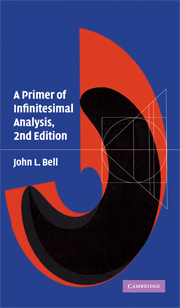Book contents
- Frontmatter
- Contents
- Preface
- Acknowledgements
- Introduction
- 1 Basic features of smooth worlds
- 2 Basic differential calculus
- 3 First applications of the differential calculus
- 4 Applications to physics
- 5 Multivariable calculus and applications
- 6 The definite integral. Higher-order infinitesimals
- 7 Synthetic differential geometry
- 8 Smooth infinitesimal analysis as an axiomatic system
- Appendix. Models for smooth infinitesimal analysis
- Note on sources and further reading
- References
- Index
8 - Smooth infinitesimal analysis as an axiomatic system
Published online by Cambridge University Press: 29 January 2010
- Frontmatter
- Contents
- Preface
- Acknowledgements
- Introduction
- 1 Basic features of smooth worlds
- 2 Basic differential calculus
- 3 First applications of the differential calculus
- 4 Applications to physics
- 5 Multivariable calculus and applications
- 6 The definite integral. Higher-order infinitesimals
- 7 Synthetic differential geometry
- 8 Smooth infinitesimal analysis as an axiomatic system
- Appendix. Models for smooth infinitesimal analysis
- Note on sources and further reading
- References
- Index
Summary
At several points we have had occasion to note the fact that logic in smooth worlds differs in certain subtle respects from the classical logic with which we are familiar. These differences have not been obtrusive, and in developing the calculus and its applications in a smooth world it has not been necessary to pay particular attention to them. Nevertheless, it is a matter of logical interest to examine these differences a little more closely, and also to formulate an explicit description of the logical system which underpins reasoning in smooth worlds.
As explained in the Introduction, any smooth world may be taken to be a certain type of category called a topos, which may be thought of as a model for mathematical concepts and operations in much the same way as the universe of set theory serves as such a model. In particular, will contain an object, which we shall denote by Ω, playing the role of the set of truth values. In set theory, Ω is the set 2 consisting of two distinct individuals true and false; we assume that, in, Ω contains at least two such distinct individuals. Now the key property of Ω in any topos is that (just as in set theory) maps from any given object X to Ω correspond exactly to parts of X, the map with constant value true corresponding to X itself, and the map with constant value false corresponding to the empty part of X.
Information
- Type
- Chapter
- Information
- A Primer of Infinitesimal Analysis , pp. 102 - 112Publisher: Cambridge University PressPrint publication year: 2008
